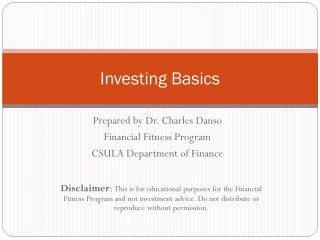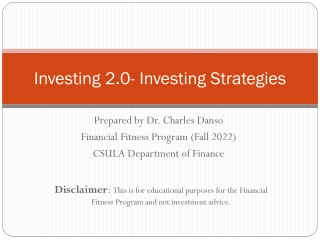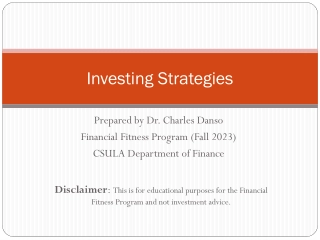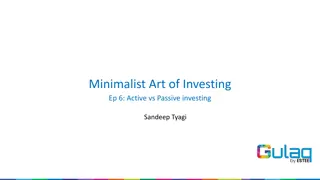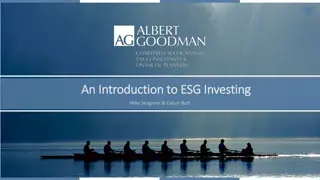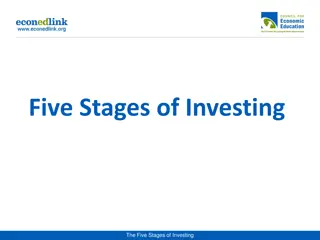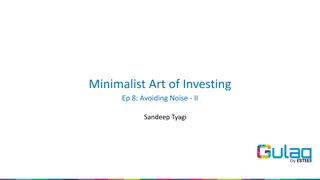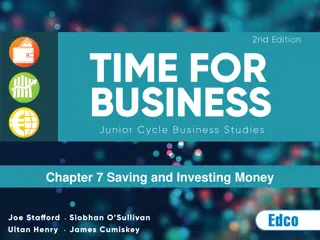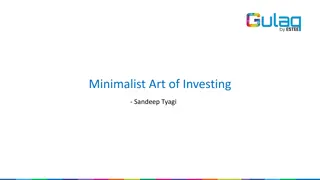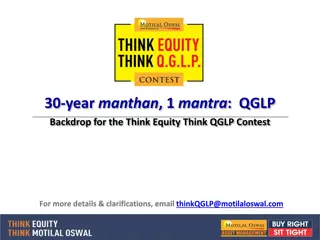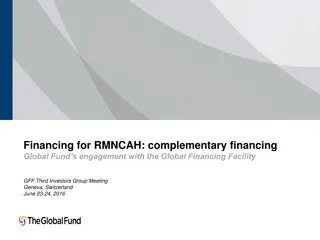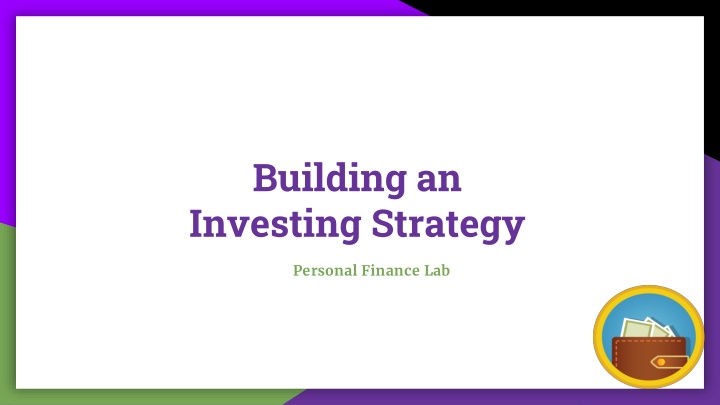
Constructing an Effective Investment Strategy for Personal Finance Growth
Learn how to build a successful investment strategy for personal finance growth by understanding key concepts such as liquidity, risk, and potential returns. Explore different security types like cash, stocks, bonds, real estate, precious metals, and derivatives. Discover tips and tricks for diversifying your portfolio and common investment strategies like Buy and Hold and Value Investing.
Download Presentation

Please find below an Image/Link to download the presentation.
The content on the website is provided AS IS for your information and personal use only. It may not be sold, licensed, or shared on other websites without obtaining consent from the author. If you encounter any issues during the download, it is possible that the publisher has removed the file from their server.
You are allowed to download the files provided on this website for personal or commercial use, subject to the condition that they are used lawfully. All files are the property of their respective owners.
The content on the website is provided AS IS for your information and personal use only. It may not be sold, licensed, or shared on other websites without obtaining consent from the author.
E N D
Presentation Transcript
Building an Investing Strategy Personal Finance Lab
Investing Vocab Investing Strategy A plan for how to save money to help it grow. An investment strategy includes more than just stocks! Liquidity How easily it can be converted into cash for other use Risk The chance of the investment to lose value Potential Returns How fast your investment can grow
Security Types Cash and Bank Deposits Liquidity: Very High Risk: Low Potential Growth: Zero or Negative Cash, believe it or not, is an investment in and of itself. Cash, and bank deposits you can withdraw right away, are the most liquid assets, since liquidity is basically how quickly you can convert any investment into cash. Certificates of Deposit Liquidity: Low Risk: Low Potential Growth: Low A Certificate of Deposit is like a savings account with a locked-in interest rate, but you cannot withdraw the cash for a certain period of time. Stocks Liquidity: High Risk: Medium Potential Growth: High Stocks is usually what comes to mind when thinking about investments. As far as an investment strategy is concerned, mutual funds and ETFs which hold stocks are all the same thing buying a piece of one or many companies in exchange for a share of their profits.
Security Types Bonds Liquidity: Medium Risk: Low Potential Growth: Medium Bonds come in three Flavors Corporate Bonds, Treasury Bonds, and other Government Bonds. Unlike stocks, a bond is a loan that you make to a company or government, and they need to pay it back plus interest. Real Estate Liquidity: Low Risk: Medium Potential Growth: Medium Real Estate includes land and buildings. You can buy and sell different real estate as an investment. Precious Metals Liquidity: High Risk: Medium Potential Growth: Medium This includes buying Gold and Silver. Many investors try to buy gold and other precious metals as an investment (and to protect against inflation). However, this often backfires. Derivatives Liquidity: Medium Risk: High Potential Growth: High Derivatives that normal investors can purchase include stock options and futures. Being a Derivative means that it derives its value from something else.
Tips and Tricks Don t Keep All Your Eggs in One Basket It is important to have a diverse investment strategy. This means that you are investing in different types of securities. This is important because it then you will have a better chance at making a return and profit from your investment. Use an Evolving Portfolio The old suggestion of more bonds as you get older is based on the idea that as you get closer to retirement, your portfolio should get more conservative. This is because you do not want to lose all of your money that you invested at an older age because you won t have time to make up for it.
Common Strategies Buy and Hold The Buy and Hold strategy is based on the idea that you do extensive research on what you re buying, choosing your investments for solid long-term reasoning, then buy it and hold on to it, regardless of what its market price does. You sell your stock when there is a major change that you don t like or you are exiting the market all together. Value Investing Value Investing is looking for stocks that are under-valued compared to the rest of the market. This means looking for companies that seem to be growing strongly but have not yet attracted much market attention, or new players with solid foundations and the potential for growth. You buy and sell these stocks at a faster rate because the prices are changing at a faster rate.

